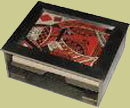|

The " King" of all gambling games in the Old West!
Faro was a very simple game. To play, you would need:
 
 
Rules of the Game.
Faro was a "banking" game where any number of players (called "punters") play against the dealer or the house, referred to as the "bank". As such, faro dealers often traveled with their gaming equipment from town to town, setting up a faro bank and often risking their personal fortune in a saloon for a fee or running a "house" bank in exchange for a piece (percentage) of the action.
The individual punters use colored chips (more commonly called "checks" or "markers") that were unique for each player. Usually one of two methods were employed. Each player would get oblong or round colored markers that were of no value, but were used to mark (identify) the owner of the bet, which would be placed under the marker with coin, cash or a number of colored valued chips. More commonly, the punter would purchase a quantity of "checks" from the dealer. The punter or dealer would agree upon a value for those "checks" at the time of purchase. The dealer would note the denomination of that particular color chip and only that player used that color, similar to roulette today.

In the Old West, ordinary faro check (chip) values ranged from "two bits" (25 cents) to $5, the most common being "four bits" (50 cents) or a dollar. $2.50 ("Quarter Eagle"), $5 ("Half Eagle"), $10 ("Eagle"), $20 ("Double Eagle") and even $50 ("Slug") gold coins were used with a lesser-valued colored check to bolster a bet. As with most "banking" games, the dealer often risked their personal fortune and therefore set the betting limits (both minimum and maximum) for their game.

The " Dealer" would shuffle the cards and place them face-up on the table (later, a dealing box came into use). The top card, visible to all, was a dead card known as 'Soda". Once the cards were shuffled and placed face up the " Punters" could place their bets. Bets could be placed directly upon a card, between two cards, cover four cards, and a number of other combinations plus " High Card".
With all bets down the dealer would remove the top card to reveal the "Banks" card (losing card for the player). If you, the player had money on that card you lost and the dealer would remove your bet. At the same time, the casekeeper would mark the card revealed on the case. Yes, the house was actually marking (counting) the cards for you. A second card would be revealed and if you had money on that card, you won. Revealing two cards constituted a "Turn". Betting continued in this fashion for 24 turns (48 cards) plus the "Soda" card for a total of 49 cards, leaving 3 cards in the box. At this point a player could choose to either bet the remaining "turn" and the game would be over. The last card, known as the "Hock" card was also a dead card. Or, the player could choose to guess the order of the remaining 3 cards. This being referred to as, " Betting the Turn". If a player could guess the correct order he was paid 4 to 1 odds, otherwise the payout was 1 to 1.
Other than the suckers bet (betting the turn) the only other advantage for the house was if two cards of the same value were revealed on a "turn". If that happened the dealer took half your bet. This was called a "Split".
Faro was commonly known as "Bucking the Tiger". A "Deal" also known as "Soda to Hock", was completed once all 52 cards were revealed.
Additional Rules and Terms:
Some " Bankers" or "Dealers" would employ a "Look-out". That person would set off to the side of the dealer and higher up. His job was to watch for cheaters. That made for not only a fun game but also a very dangerous game. All involved in the game could be armed and little infractions sometimes resulted in gun play. You may remember the person tracking the cards played was referred to as the "Casekeeper". He was also known as the "Cue" keeper or the "Coffin" keeper. It was not wise to make a mistake in tracking the cards.
Flat or Flat Foot - term used when a bet was placed on a single card.
Snowout - term used when a player requested the dealer to place all cards, face-up, on the table.
To "Bar" a bet - player elects to suspend a bet during the game.
"It Goes" - statement used by player when he wants his suspended bet put back in play.
Coppering a bet - when a player placed a copper on his bet to reverse it from win to lose.
Cat or Cat Hop- when 2 of the remaining 3 cards are of the same denomination. When this happened the dealer only paid 2 to 1 odds for guessing the " Turn".
Sleeper - a bet that has been forgotten by it's owner and could be claimed by anyone.
Ok, like anything new, this seems like a lot to remember but don't fret. Go to Wichita Faro and learn to play online, it's a blast.
Wichita Faro

|